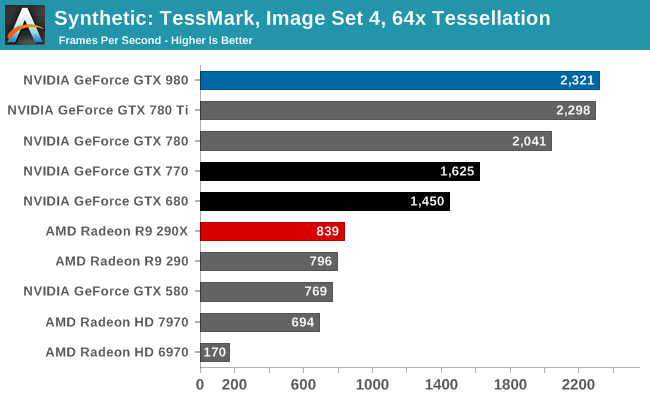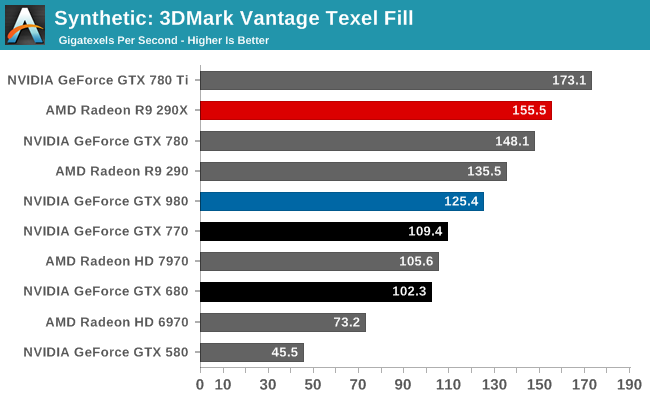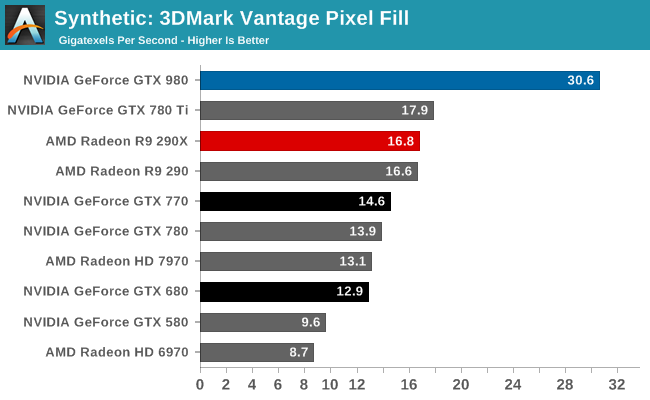The NVIDIA GeForce GTX 980 Review: Maxwell Mark 2
by Ryan Smith on September 18, 2014 10:30 PM ESTSynthetics
As always we’ll also take a quick look at synthetic performance. These tests mainly serve as a canary for finding important architectural changes, and with the exception of pixel throughput we are not expecting any major changes for GTX 980 and GM204.

GM204 is designed to have an ever-so-slightly higher triangle throughput rate than GK110 – 16 tris/clock versus 15 tris/clock, and sure enough the GTX 980 comes out on top in TessMark, slightly edging out the GTX 780 Ti. The difference is only very slight here, and though GM204 should be a bit more powerful than GK110 in practice it’s a dead heat.
Moving on, we have our 3DMark Vantage texture and pixel fillrate tests, which present our cards with massive amounts of texturing and color blending work. These aren’t results we suggest comparing across different vendors, but they’re good for tracking improvements and changes within a single product family.

Beginning with Maxwell NVIDIA reduced their texture-to-compute ratio from 12:1 to 16:1. As a result of this change Maxwell GPUs have fewer texture units than comparable Kepler GPUs. Compounding this effect is the fact that Maxwell CUDA cores are more efficient than Kepler CUDA cores, leading to NVIDIA placing fewer cores overall and further reducing the texture fill rate.
As a result the GTX 980 is not texture fillrate competitive with any of the GK110 cards. It is competitive with the GK104 cards, but only because these cards had the same number of texture units at 128. NVIDIA has told us that they believe this new ratio is a better fit for modern workloads, and judging from the performance we’re seeing elsewhere it would appear that NVIDIA is right.

On the other hand, thanks to NVIDIA’s newer 3rd generation delta color compression technology, our 3DMark pixel fillrate performance is through the roof. GTX 980 comes very close to doubling the throughput of our GK110 cards and more than doubles the throughput of the GK104 cards, reflecting the fact that it has 64 ROPs and more importantly has the available bandwidth to put them to good use.
This benchmark in a nutshell is why NVIDIA can deliver chart-topping performance despite having only 2/3rds the memory bandwidth of GTX 780 Ti. By improving their color compression to this point, NVIDIA can significantly reduce their memory bandwidth requirements Maxwell 2, allowing them to do more with less. In real games the result won’t be anywhere near this remarkable since this is a pure pixel fillrate test, but it goes to show that NVIDIA has been able to expand their effective memory bandwidth in concert with their ROP and shader performance improvements.










274 Comments
View All Comments
Ryan Smith - Thursday, September 18, 2014 - link
As noted in the article, we had a problem with our 970 sample that was not able to be resolved in time for this article. Otherwise I would have very much liked to have a 970 in this review.Sunrise089 - Friday, September 19, 2014 - link
"Focus on quality first, then timeliness second. There's value in both but there's more value in one." :(extide - Friday, September 19, 2014 - link
Yeah guys, seriously just make the article live a little bit late!hpglow - Friday, September 19, 2014 - link
The boss quits and all you guys around running around the office with your shirts off screaming at the top of your lungs? The review could have waited and hour or two so that it was done, now I'm not even going to finish reading it.iLovefloss - Friday, September 19, 2014 - link
They've been doing this since forever. If you look at the comments from the R9 290X launch review, people were complaining about the same thing for example.Sunrise089 - Friday, September 19, 2014 - link
Including me. It was unacceptable clIck-baiting then and it still is. Interestingly enough it's not a site-wide issue. Surface Pro 3 and Devils Canyon both had long waits for ultimately excellent reviews. iPhone 6 will no doubt be a very popular review and yet Joshua or whoever didn't push it online at midnight. For whatever reason though GPU reviews get this weird 'rush to publish, fill in content later' pattern.djscrew - Friday, September 19, 2014 - link
diva much? jeez give it a restnathanddrews - Friday, September 19, 2014 - link
This is not the first time AT has done this, there have been many other incomplete reviews published over the years (decades).chizow - Friday, September 19, 2014 - link
@hpglow, in Ryan's defense, it was a short turnaround from the press briefing and this has happened in the past. Usually AT's articles focus heavily on the technical aspects also (which is greatly appreciated throughout the industry) and he also gets help from the rest of the staff to stitch the review together, so it is understandable that it is sometimes uploaded piecemeal.I would rather have something that is eventually updated that stands the test of time, vs. something that is rushed out hastily.
SodaAnt - Friday, September 19, 2014 - link
You think that it would only take an hour or two to get a gpu somehow, run dozens of tests on it, put those tests into tables, put those tables onto pages, then write another few thousand words on those tests?